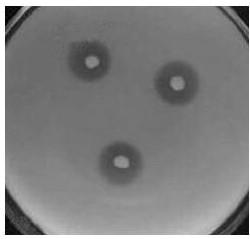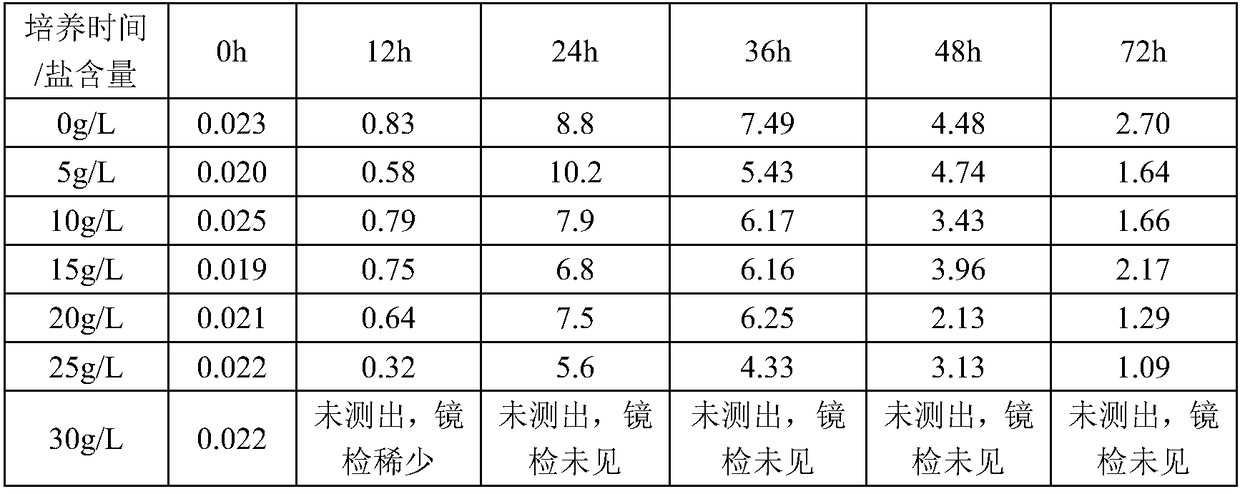Application of bacillus subtilis in soil phosphorus decomposition and cellulose degradation
A Bacillus subtilis, cellulose degradation technology, applied in the application, soil conditioning materials, chemical instruments and methods, etc., can solve problems such as direct burning or discarding, waste of resources, environment, pollution, etc.
- Summary
- Abstract
- Description
- Claims
- Application Information
AI Technical Summary
Problems solved by technology
Method used
Image
Examples
Embodiment 1
[0014] The preparation of embodiment 1 bacillus subtilis (Bacillus subtilis) XF-1 bacterial agent
[0015] This example introduces the preparation of Bacillus subtilis (Bacillus subtilis) XF-1 bacterial agent.
[0016] 1. Preparation of Bacillus subtilis XF-1 liquid preparation
[0017] Activation of Bacillus subtilis (Bacillus subtilis) XF-1: From the slant of Bacillus subtilis (Bacillus subtilis) XF-1, use a sterile inoculation needle to pick part of the bacterial lawn into LB shake flasks (LB liquid culture in 250mL shake flasks 50ml of base solution), after culturing at 30°C and 150r / min for 24h, the LB medium became turbid. Take the bacterial liquid and streak it into the LB solid medium for 24h-36h. Bacillus subtilis XF-1 grows well on the LB solid medium. The colonies are white or off-white, with smooth edges, irregular surface, and opaque.
[0018] Preparation of seed solution: the liquid volume of LB liquid medium in the 500mL seed shake flask is 150ml. Pick a sing...
Embodiment 2
[0028] The salt tolerance of embodiment 2 bacillus subtilis (Bacillus subtilis) XF-1
[0029] Basal medium: glucose 20g / L, yeast extract 5g / L, pH 7-7.5.
[0030] By adding different amounts of sodium chloride in the basal medium, the final concentration of sodium chloride was 0g / L, 5g / L, 10g / L, 15g / L, 20g / L, 25g / L and 30g / L respectively. liquid medium.
[0031] Shake flask culture conditions: the filling volume of the liquid culture medium in the 250mL shake flask is 50ml. Inoculum volume: 1mL seed solution / shake flask. Cultivate on a shaker at 30°C and 150r / min for 72 hours, and take samples every 12 hours to determine the content of viable bacteria.
[0032] Table 1 Bacillus subtilis XF-1 cultivated live bacteria content (10 8 cfu / mL)
[0033]
[0034] It can be seen from Table 1 that Bacillus subtilis (Bacillus subtilis) XF-1 can grow normally under the salt concentration of 25g / L, and has high salt tolerance.
[0035]In the process of utilization, saline-alkali la...
Embodiment 3
[0037] The phosphorus solubilizing effect of embodiment 3 bacillus subtilis (Bacillus subtilis) XF-1
[0038] 1. Determination of the phosphorus-solubilizing effect of Bacillus subtilis by plate lysing zone method
[0039] Phosphorus solubilizing ability is an important index to characterize the phosphorus solubilizing effect of microorganisms. Generally, both qualitative and quantitative methods can be used.
[0040] way.
[0041] The qualitative method generally refers to the plate lysate zone method. Plate lysis zone method: culture phosphate-dissolving strains on a solid plate medium containing insoluble phosphate, and measure the size of the transparent zone produced by the colony. The ratio (D / d) of the diameter of the phosphorus-dissolving circle (D) to the diameter of the colony growth (d) was used to characterize the relative phosphorus-solubilizing ability of the phosphorus-solubilizing bacteria.
[0042] The medium used in the plate lysing zone method is Montkina...
PUM
 Login to View More
Login to View More Abstract
Description
Claims
Application Information
 Login to View More
Login to View More - R&D
- Intellectual Property
- Life Sciences
- Materials
- Tech Scout
- Unparalleled Data Quality
- Higher Quality Content
- 60% Fewer Hallucinations
Browse by: Latest US Patents, China's latest patents, Technical Efficacy Thesaurus, Application Domain, Technology Topic, Popular Technical Reports.
© 2025 PatSnap. All rights reserved.Legal|Privacy policy|Modern Slavery Act Transparency Statement|Sitemap|About US| Contact US: help@patsnap.com



